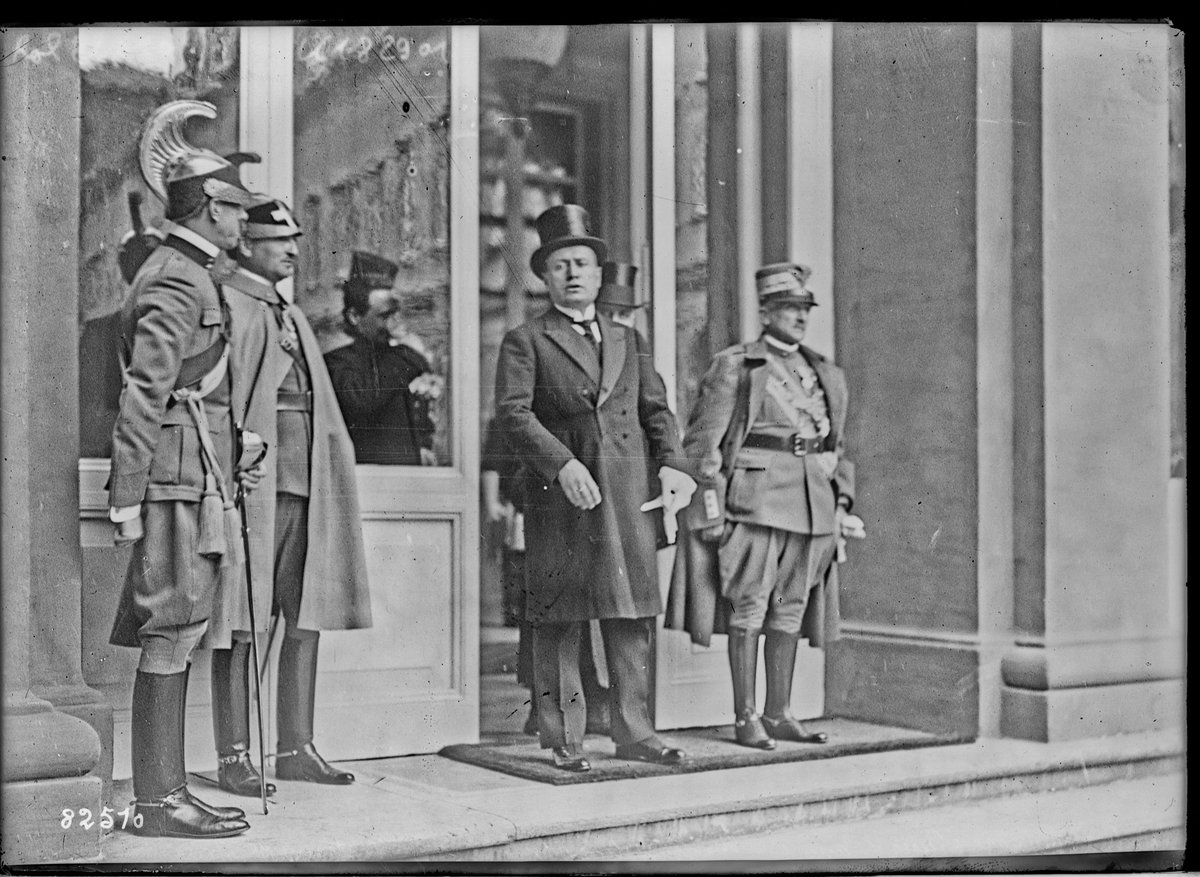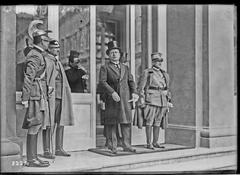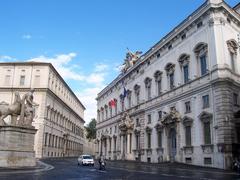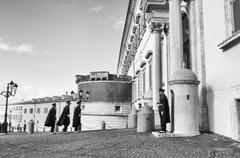
Quirinal Palace Rome: Visiting Hours, Tickets, and Complete Guide
Date: 14/06/2025
Introduction
The Quirinal Palace (Palazzo del Quirinale) stands atop Rome’s highest hill as a monumental testament to the city’s political, artistic, and historical legacy. Originally built as a papal summer residence in 1583, it has since served as the royal home of Italy’s kings and is now the official residence and workplace of the President of the Italian Republic. The palace’s vast and richly ornamented interiors, grand ceremonial halls, and lush gardens make it a highlight for anyone seeking to understand Italy’s centuries of statecraft and culture. This guide details everything you need to plan your visit, including Quirinal Palace visiting hours, ticketing, accessibility, and nearby attractions.
For up-to-date details, consult Wikipedia, Google Arts & Culture, Italiani.it, and Turismo Roma.
Historical Overview
Ancient and Papal Origins
The Quirinal Hill, the highest of Rome’s famed seven hills, has been significant since antiquity, once home to Roman temples and patrician villas. The palace’s modern story begins in 1583 when Pope Gregory XIII commissioned Ottaviano Mascherino to design a summer retreat, seeking healthier air than the Tiber’s banks provided (Wikipedia). While the Pope’s death in 1585 halted the initial phase, the north wing and the panoramic Torre dei Venti (“Tower of the Winds”) remain from this era (Wikipedia; Turismo Roma).
Expansion and Architectural Evolution
Successive popes and, later, Italian monarchs expanded the palace over four centuries. Renowned architects including Domenico Fontana, Carlo Maderno, Gian Lorenzo Bernini, and Ferdinando Fuga contributed to its transformation, blending Renaissance, Baroque, and Neoclassical styles (Romeing; My Rome Pass). The palace now encompasses a sprawling 110,500 square meters and over 1,200 rooms—making it one of Europe’s largest palaces (Wanted in Rome; Wikipedia).
From Papal to Royal and Republican Residence
For over three centuries, the palace was the administrative and summer residence of the popes, hosting conclaves and key ecclesiastical ceremonies (Rome.us). After Rome’s annexation in 1870, it became the royal residence of the Kings of Italy, and since 1946, the official seat of the President of the Italian Republic (Wikipedia). Today, it is both a functioning seat of state and a public museum (My Rome Pass).
Architectural and Artistic Highlights
Layout and Signature Features
- Courtyard of Honor (Cortile d’Onore): An imposing arcaded square at the heart of the palace, reflecting centuries of architectural interventions (Google Arts & Culture).
- Torrino and Bell Tower: The palace’s panoramic tower and unique Roman six-hour dial clock, topped with mosaics of the Madonna and Child (Google Arts & Culture).
- Staircase of Honor (Scala d’Onore): A Baroque double-ramp masterpiece by Flaminio Ponzio, grandly connecting ceremonial spaces (Google Arts & Culture).
- Mascarino Staircase: A visually stunning spiral staircase exemplifying late Renaissance design (Port Mobility).
- Grand Reception Rooms: Includes the Salone dei Corazzieri, Ballroom, Hall of Mirrors, and the Pauline Chapel, each reflecting the tastes of their era (Port Mobility).
Artistic Masterpieces
- Frescoes and Paintings: Works by Caravaggio, Raphael, Titian, Guido Reni, Melozzo da Forlì, and others adorn walls and ceilings (My Rome Pass; Google Arts & Culture).
- Decorative Arts: Murano glass chandeliers, tapestries, period furnishings, and a celebrated collection of historical carriages (Port Mobility).
- Gardens: The Quirinal Gardens, redesigned in the 18th century, offer rare plants, historic fountains, and views over Rome (Google Arts & Culture).
Institutional and Ceremonial Role
Since 1946, the Quirinal Palace has been the official residence of the President of the Italian Republic (Le Monde). It hosts the swearing-in of governments, state banquets, diplomatic ceremonies, and annual Republic Day celebrations (Turismo Roma). The palace’s ceremonial spaces, such as the Gallery of Regions with flags from all Italian regions, underscore its ongoing political significance (Google Arts & Culture).
Visiting the Quirinal Palace
Visiting Hours
- General Hours: Open to visitors Tuesday to Sunday, typically from 9:00 AM to 6:00 PM (last entry at 4:00 PM). Visiting hours may vary on holidays or due to official events—always confirm via the official website.
- Special Openings: Occasional free access events during cultural initiatives or national celebrations (Turismo Roma).
Tickets and Reservations
- Ticketing: Standard adult admission is €10–€12. Reduced rates apply for EU citizens aged 18–25; free for children under 18. Some events may be free, with a nominal reservation fee (Italiani.it).
- Booking: Tickets are nominative, must be booked online in advance, and require valid ID at entry. Book at least five days ahead, especially during peak periods (Italiani.it).
- Entry: Groups of up to 30 people are admitted every 20 minutes. Security screening is required.
Guided Tours
- Languages: Tours are mainly in Italian, with select English tours and audio guides available.
- Duration: Standard tours last 60–90 minutes and cover highlights such as the Hall of Mirrors, Pauline Chapel, and gardens.
- Special Tours: Thematic tours focus on the gardens, presidential collections, or temporary exhibitions.
Accessibility
- Mobility: Most public areas are wheelchair accessible; some historic sections may be limited. Contact visitor services in advance for accommodations.
- Families: Strollers are not permitted inside, but baby carriers are allowed. Family-friendly tours are available during school holidays.
Visitor Experience and Practical Tips
- Dress Code: Respectful attire is required; shoulders and knees should be covered.
- Security: Airport-style screening; avoid bringing large bags or sharp objects.
- Photography: Permitted in designated areas without flash or tripods.
- Facilities: Restrooms, cloakroom, and a gift shop are available.
- Best Times: Early morning or late afternoon on weekdays for fewer crowds.
- Weather: Summers are hot; bring sun protection and water.
Changing of the Guard
- When: Sundays at 4:00 PM, a ceremonial Changing of the Guard takes place in Piazza del Quirinale—free and open to the public (Rome Actually).
COVID-19 and Health
- Masks are recommended indoors in crowds; hand sanitizing stations are provided. Check current health guidelines before your visit.
Nearby Attractions
- Trevi Fountain: 10-minute walk.
- Spanish Steps and Piazza Venezia: Within 15 minutes on foot.
- Via del Quirinale: Offers historic churches, artisan shops, and vibrant local life.
Frequently Asked Questions (FAQ)
Q: What are the Quirinal Palace visiting hours?
A: Tuesday to Sunday, 9:00 AM–6:00 PM (last entry at 4:00 PM). Confirm via the official website.
Q: How do I book tickets?
A: Book online through the official portal at least five days in advance.
Q: Are guided tours available in English?
A: Yes, though limited. Audio guides in multiple languages are available.
Q: Is the palace wheelchair accessible?
A: Most areas are accessible; contact staff for arrangements.
Q: Can I take photographs?
A: Yes, in designated areas without flash or tripods.
Virtual Visits
For those unable to attend in person, explore the palace’s rooms and gardens via a detailed virtual tour (Italiani.it).
Visual Gallery

Alt text: Monumental Baroque marble staircase inside Quirinal Palace.
Alt text: Quirinal Palace gardens overlooking the city of Rome.
Summary and Final Tips
The Quirinal Palace is a living monument to Italy’s rich past and vibrant present. Its blend of architectural splendor, artistic treasures, and ongoing institutional role makes it a cornerstone of Rome’s cultural heritage. By planning ahead—booking your tickets, checking visiting hours, and considering guided tours—you’ll be able to appreciate highlights like the Hall of Mirrors, Pauline Chapel, and Quirinal Gardens. Its central location allows you to conveniently pair your visit with other major Roman attractions.
Use official resources or the Audiala app for up-to-date guidance, audio tours, and special content to enrich your experience (My Rome Pass; Romeing; Italiani.it; Turismo Roma).
Sources
- Quirinal Palace Wikipedia, 2025, Various Authors
- Quirinal Palace and Square, Turismo Roma, 2025
- Visit Palazzo del Quirinale, Romeing, 2025
- Quirinal Palace, My Rome Pass, 2025
- Visiting Italy’s Quirinal Palace in Rome, Wanted in Rome, 2025
- Quirinal Palace Official Visit Information, Italiani.it, 2025
- Welcome to the Quirinal Palace, Google Arts & Culture, 2025
- June 2025 Rome Discover and Experience Rome, Turismo Roma, 2025
- Sergio Mattarella, President of the Italian Republic, Le Monde, 2025
- Quirinal Palace Finally Open to Public, Port Mobility Civitavecchia, 2025
- Triphobo: Quirinal Palace, 2025
- Rome Actually: Visiting Rome in June, 2025
- Quirinal Palace Official Website, 2025




















































































































































































































































